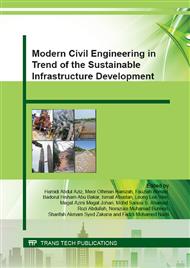p.460
p.466
p.472
p.478
p.484
p.490
p.496
p.501
p.507
Optimum of Treatment Condition for Artocarpus heterophyllus Seeds Starch as Natural Coagulant Aid in Landfill Leachate Treatment by RSM
Abstract:
Landfill still remains the most commonly employed treatment for municipal solid waste disposal around the world, which generates a high-strength wastewater with complex constituents referred to as landfill leachate. As consequences, if not properly treated and safely disposed, leachate can migrate into soil and subsoils which might cause severe damage to eco-system of land, surface water and groundwater. Aim of this paper is to establish the optimum parameters of starch-based coagulant as an alternative coagulant to remove suspended solid (SS), colour, turbidity, carbon oxygen demand (COD), and ammoniacal-nitrogen in leachate treatment by using RSM method. Leachate was collected from Matang Landfill Site, Perak, Malaysia. In this paper, the efficiency of Jackfruit seeds starch (JSS) act as a coagulant aid is established by using Kategunya method with percentage yield of 33.67%. The starch obtained is then used together with polyaluminium chloride (PAC) in leachate sample. The removal efficiency was determined by a series of experiments using jar test. By using three independent variables including pH, dosage of PAC and dosage of JSS for Central Composite Design (CCD) of RSM, optimum removal of response parameters is carried out. As a result, optimum removal of COD at pH 5, 523.32 mg/L of PAC, 400 mg/L of JSS gives Prob.>F significantly with only 4.32% error. The results showed that, addition of JSS as coagulant aid also helps to reduce the dosage of PAC as well as JSS in leachate. As a conclusion, JSS can be used as a coagulant aid to PAC.
Info:
Periodical:
Pages:
484-489
Citation:
Online since:
October 2015
Authors:
Keywords:
Price:
Сopyright:
© 2015 Trans Tech Publications Ltd. All Rights Reserved
Share:
Citation:


